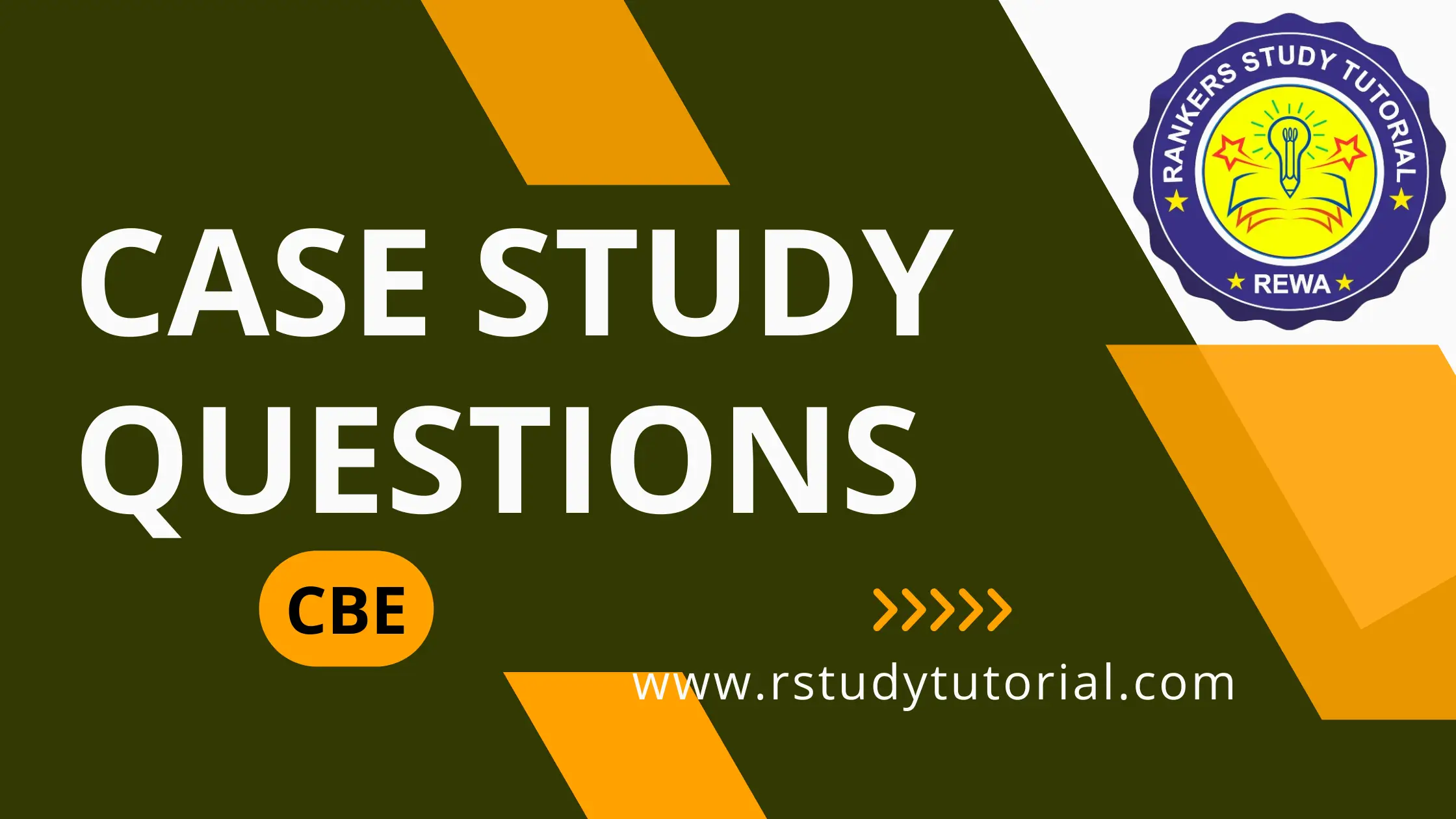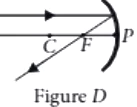Case Study Question 01
Read the following and answer any four questions from 1 to 5.
The refraction of light on going from one medium to another takes place according to two laws which are known as the laws of refraction of light. These laws are
1. The ratio of sine of angle of incidence to the sine of angle of refraction is always constant for the pair of media in contact.
\frac{\sin i}{\sin r} = μ = constant
This constant is called refractive index of the second medium with respect to the first medium. Refractive index is also defined as the ratio of speed of light in vacuum to the speed of light in medium.
2. The incident ray, refracted ray and normal all lie in the same plane.
This law is called Snell’s law of refraction.
Question.1. When light travels from air to glass,
(a) angle of incidence > angle of refraction
(b) angle of incidence < angle of refraction
(c) angle of incidence = angle of refraction
(d) can’t say
Question.2. When light travels from air to medium, the angle of incidence is 45° and angle of refraction is 30°. The refractive index of second medium with respect to the first medium is
(a) 1.41
(b) 1.50
(c) 1.23
(d) 1
Question.3. In which medium, the speed of light is minimum?
(a) Air
(b) Glass
(c) Water
(d) Diamond
Question.4. If the refractive index of glass is 1.5 and speed of light in air is 3 \times 10^{8} m/s. The speed of light in glass is
(a) 2 \times 10^{8} m/s
(b) 2.9 \times 10^{8} m/s
(c) 4.5 \times 10^{8} m/s
(d) 3 \times 10^{8} m/s
Question.5. Refractive index of a with respect to b is 2. Find the refractive index of b with respect to a.
(a) 0.4
(b) 0.5
(c) 0.25
(d) 2.
Ans.1. (a)
According to Snell’s law of refraction,
\frac{\sin i}{\sin r} >1
or
i > r
Ans.2. (a)
As, _{1}\mu^{2}=\frac{\sin i}{\sin r}
⇒ \frac{\sin 45°}{\sin 30°}=\frac{\frac{1}{\sqrt{2}}}{\frac{1}{2}}= 1.41
Ans.3. (d)
As diamond has maximum value of refractive index, therefore it has minimum speed of light in medium.
Ans.4. (a)
As, \mu_{glass}=1.5, c= 3\times 10^{8} m/s
⇒ \mu = \frac{c}{v}
⇒ 1.5 = \frac{3\times 10^{8}}{v}
⇒ v = 2\times 10^{8} m/s
Ans.5. (b)
Given, refractive index of a with respect to b is _{b}\mu^{a}=2
Therefore, Refractive index of b with respect to a is
\frac{1}{_{b}\mu^{a}}
⇒ _{a}\mu^{b}=\frac{1}{2} =0.5
Case Study Question 02
Read the following and answer any four questions from 1 to 5.
A lens is a piece of any transparent material bounded by two curved surfaces. There are two types of lenses convex lens and concave lens.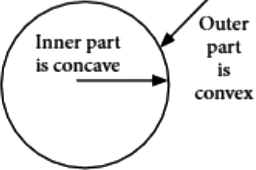
A point on the principal axis, where the incident parallel rays meet or appears to come out after refraction is called focus.
A convex lens converges a parallel beam of light to other side whereas concave lens spreads out.
Question.1. Which of the following lenses would you prefer to use while reading small letters found in dictionary?
(a) A convex lens of focal length 50 cm
(b) A concave lens of focal length 50 cm
(c) A convex lens of focal length 5 cm
(d) A concave lens of focal length 5 cm
Question.2. Which type of lenes are shown in given figure (i) and (ii).
(a) Plano concave, concavo convex
(b) Plano convex, convexo concave
(c) Double concave, concave convex
(d) Convexo concave, double convex
Question.3. A small bulb is placed at the focal point of a converging lens. When the bulb is switched on, the lens produces
(a) a convergent beam of light
(b) a divergent beam of light
(c) a parallel beam of light
(d) a patch of coloured light.
Question.4. The part of lens through which the refraction takes place is called
(a) aperture
(b) centre of curvature
(c) principal axis
(d) focus
Question.5. A water drop acts as a
(a) convex lens
(b) concave lens
(c) double concave lens
(d) none of these
Ans.1. (c)
Convex lens is used as magnifying glass. For better performance its focal length should be small.
Ans.2. (a)
Ans.3. (c)
Ans.4. (a)
A aperture is the area of the lens available for refraction.
Ans.5. (a)
Water droplets behave like a convex lens only as refraction takes place on outer surface.
Case Study Question 03
Read the following and answer any four questions from 1 to 5.
The lenses forms different types of images when object placed at different locations. When a ray is incident parallel to the principal axis, then after refraction, it passes through the focus or appears to come from the focus. When a ray goes through the optical centre of the lens, it passes without any deviation.
If the object is placed between focus and optical center of the convex lens, erect and magnified image is formed. As the object is brought closer to the convex lens from infinity to focus, the image moves away from the convex lens from focus to infinity. Also the size of image goes on increasing and the image is always real and inverted. A concave lens always gives a virtual, erect and diminished image irrespective to the position of the object.
Question.1. The location of image formed by a convex lens when the object is placed at infinity is
(a) at focus
(b) at 2F
(c) at optical center
(d) between F and 2F
Question.2. When the object is placed at the focus of concave lens, the image formed is
(a) real and smaller
(b) virtual and inverted
(c) virtual and smaller
(d) real and erect
Question.3. The size of image formed by a convex lens when the object is placed at the focus of convex lens is
(a) small
(b) point in size
(c) highly magnified
(d) same as that of object
Question.4. When the object is placed at 2F in front of convex lens, the location of image is
(a) at F
(b) at 2F on the other side
(c) at infinity
(d) between F and optical center
Question.5. At which location of object in front of concave lens, the image between focus and optical centre is formed
(a) anywhere between centre and infinity
(c) at 2F
(b) at F
(d) infinity
Ans.1. (a)
When an object is placed at infinity of convex lens, image will be formed at focus F.
Ans.2. (b)
Virtual and inverted image is formed, when object is placed at focus of the concave lens.
Ans.3. (c)
When object is placed at focus of a convex lens, highly enlarged or magnified image is formed.
Ans.4. (b)
When an object is placed at distance 2F in front of a convex lens, then the image formed is at a distance 2F on the other of the lens.
Ans.5. (a)
Image if formed between focus and optical centre when the object is placed anywhere between optical centre and infinity.
Case Study Question 04
Read the following and answer any four questions from 1 to 5.
The relationship between the distance of object from the lens ( u ), distance of image from the lens ( v ) and the focal length ( f ) of the lens is called lens formula. It can be written as \frac{1}{f}=\frac{1}{v}-\frac{1}{u}
The size of image formed by a lens depends on the position of the object from the lens. A lens of short focal length has more power whereas a lens of long focal length has less power. When the lens is convex, the power is positive and for concave lens, the power is negative.
The magnification produced by a lens is the ratio of height of image to the height of object as the size of the image relative to the object is given by linear magnification ( m ).
When, m is negative, image formed is real and when m is positive, image formed is virtual. If m<1 , size of image is smaller than the object. If m>1 , size of image is larger than the object.
Question.1. An object 4 cm in height is placed at a distance of 10 cm from a convex lens of focal length 20 cm. The position of image is
(a) – 20 cm
(b) 20 cm
(c) -10 cm
(d) 10 cm
Question.2. In the above question, the size of image is
(a) 16 cm
(b) 8 cm
(c) 4 cm
(d) 2 cm
Question.3. An object is placed 50 cm from a concave lens and produces a virtual image at a distance of 10 cm infront of lens. The focal length of lens is
(a) -25 cm
(b) -12.5 cm
(c) 12.5 cm
(d) 10 cm
Question.4. A convex lens forms an image of magnification -2 of the height of image is 6 cm, the height of object is
(a) 6 cm
(b) 4 cm
(c) 3 cm
(d) 2 cm
Question.5. A concave lens of focal length 5 cm, the power of lens is
(a) 20 D
(b) -20 D
(c) 90 D
(d) -5 D
Ans.1. (a)
Given, f = 20 cm, u = -10 cm
Using, \frac{1}{f} = \frac{1}{v}- \frac{1}{u}
⇒ \frac{1}{20} = \frac{1}{(v)} – \frac{1}{-10}
⇒ v = -20 cm
Ans.2. (b)
As, m = \frac{v}{u}= \frac{-20}{-10}=2
Therefore, m = \frac{h_{2}}{h_{1}}
⇒ 2 = \frac{h_{2}}{4}
⇒ h_{2} = 8 cm
Ans.3. (b)
Here u = -50 cm, v = 10 cm, v = 10 cm, f = ?
Using, \frac{1}{f} = \frac{1}{10}- \frac{1}{50}
⇒ f = -12.5 cm
Ans.4. (c)
Here, m = -2 , h_{2} = -6 cm, h_{1} = ?
As, m = \frac{h_{2}}{h_{1}}
⇒ -2 = \frac{-6}{h_{1}}
⇒ h_{1} = 3 cm
Ans.5. (b)
As P = \frac{1}{f} (Since, f = 5 cm)
⇒ P = \frac{-1}{0.05 m}=-20 D
Case Study Question 05
Read the following and answer any four questions from 1 to 5.
The curved surface of a spoon can be considered as a spherical mirror. A highly smooth polished surface is called mirror. The mirror whose reflecting surface is curved inwards or outwards is called a spherical mirror. Inner part works as a concave mirror and the outer bulging part acts as a convex mirror. The center of the reflecting surface of a spherical mirror is called pole and the radius of the sphere of which the mirror is formed is called radius of curvature.
Question.1. When a concave mirror is held towards the sun and its sharp image is formed on a piece of carbon paper for some time, a hole is burnt in the carbon paper. What is the name given to the distance between the mirror and carbon paper?
(a) Radius of curvature
(c) Principal focus
(b) Focal length
(d) Principal axis
Question.2. The distance between pole and focal point of a spherical mirror is equal to the distance between
(a) pole and center of curvature
(b) focus point and center of curvature
(c) pole and object
(d) object and image.
Question.3. The focal length of a mirror is 15 cm. The radius of curvature is
(a) 15 cm
(b) 30 cm
(c) 45 cm
(d) 60 cm
Question.4. The normal at any point on the mirror passes through
(a) focus
(b) pole
(c) center of curvature
(d) any point
Question.5. In a convex spherical mirror, reflection of light takes place at
(a) a flat surface
(b) a bent-in surface
(c) a bulging-out surface
(d) an uneven surface
Ans.1. (b)
The focal length of a concave mirror is the distance between its pole and principal focus.
Ans.2. (b)
Ans.3. (b)
Given that, ƒ = 15 cm
Radius of curvature of a spherical mirror is given as R = 2F
R = 2 x 15 = 30 cm
Ans.4. (c)
In a spherical mirror, normal drawn at any point passes through the centre of curvature.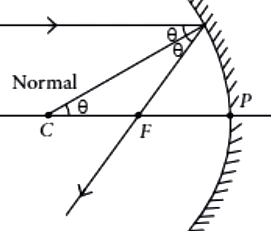
Case Study Question 06
Read the following and answer any four questions from 1 to 5.
The spherical mirror forms different types of images when the object is placed at different locations.
When the image is formed on screen, the image is real and when the image does not form on screen, the image is virtual. When the two reflected rays meet actually, the image is real and when they appear to meet, the image is virtual.
A concave mirror always forms a real and inverted image for different positions of the object. But if the object is placed between the focus and pole, the image formed is virtual and erect.
A convex mirror always forms a virtual, erect and diminished image. A concave mirror is used as doctor’s head mirror to focus light on body parts like eyes, ears, nose etc., to be examined because it can form erect and magnified image of the object. The convex mirror is used as a rear view mirrors in automobiles because it can form an small and erect image of an object.
Question.1. When an object is placed at the centre of curvature of a concave mirror, the image formed is
(a) larger than the object
(b) smaller than the object
(c) same size as that of the object
(d) highly enlarged.
Question.2. No matter how far you stand from a mirror, your image appears erect. The mirror is likely to be
(a) plane
(b) concave
(c) convex
(d) either plane or convex.
Question.3. A child is standing in front of a magic mirror. She finds the image of her head bigger, the middle portion of her body of the same size and that of the legs smaller. The following is the order of combinations for the magic mirror from the top.
(a) Plane, convex and concave
(b) Convex, concave and plane
(c) Concave, plane and convex
(d) Convex, plane and concave
Question.4. To get an image larger than the object, one can use
(a) convex mirror but not a concave mirror
(b) a concave mirror but not a convex mirror
(c) either a convex mirror or a concave mirror
(d) a plane mirror.
Question.5. A convex mirror has wider field of view because
(a) the image formed is much smaller than the object and large number of images can be seen.
(b) the image formed is much closer to the mirror
(c) both (a) and (b)
(d) none of these.
Ans.1. (c)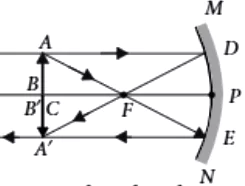
Ans.2. (d)
The image is erect in a plane mirror and also in a convex mirror, for all positions of the object.
Ans.3. (c)
As the image of head is bigger, the upper portion of magic mirror is concave. The middle portion of the image is of same size, so, middle portion of magic mirror is plane. Now, the image of legs looks smaller, therefore, the lower portion of magic mirror is convex.
Ans.4. (b)
Ans.5. (c)
Case Study Question 07
Read the following and answer any four questions from 1 to 5.
The relation between distance of an object from the mirror ( u ), distance of image from the mirror ( v ) and the focal length ( f ) is called mirror formula. This formula is valid in all situations for all spherical mirrors for all positions of the object. The size of image formed by a spherical mirror depends on the position of the object from the mirror. The image formed by a spherical mirror can be bigger than the object, equal to the object or smaller than the object. The size of the image relative to the object is given by the linear magnification (m). Thus, the magnification is given by the ratio of height of image to the height of object. If magnification is negative, image is real and if it is positive, image is virtual.
Question.1. What is the position of an image when an object is placed at a distance of 20 cm from a concave mirror of focal length 20 cm?
(a) 5 cm
(b) 20 cm
(c) 10 cm
(d) infinity
Question.2. Which of the following ray diagrams is correct for the ray of light incident on a concave mirror as shown in figure?
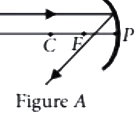
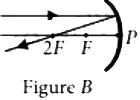

(a) Figure A
(b) Figure B
(c) Figure C
(d) Figure D
Question.3. If the magnification of an image is -2, the characteristic of image will be
(a) real and inverted
(b) virtual and enlarged
(c) virtual and inverted
(d) real and small
Question.4. The mirror formula holds for
(a) concave mirror
(b) convex mirror
(c) plane mirror
(d) all of these
Question.5. A parallel beam of light is made to fall on a concave mirror. An image is formed at a distance of 7.5 from the mirror. The focal length of the mirror is
(a) 15 cm
(b) 7.5 cm
(c) 3.75 cm
(d) 10 cm
Ans.1. (d)
When an object is placed at the focus of a concave mirror, the image is formed at infinity.
Ans.2. (d)
When a light ray parallel to the principal axis is incident on a concave mirror, it passes through the principal focus after reflection. Therefore, figure D is correct.
Ans.3. (a)
If m is negative, the image will be real and inverted.
Ans.4. (d)
Ans.5. (b)
The distance of object from mirror = ∞
Using, \frac{1}{v}+ \frac{1}{u}= \frac{1}{f}
⇒ \frac{1}{∞}- \frac{1}{(-7.5)}= \frac{1}{f}
⇒ f = 7.5 cm
Case Study Question 08
Read the following and answer any four questions from 1 to 5.
When the rays of light travels from one transparent medium to another, the path of light is deviated. This phenomena is called refraction of light. The bending of light depends on the optical density of medium through which the light pass.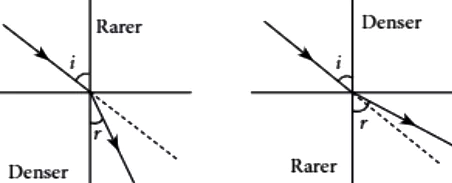
Question.1. When light travels from air to glass, the ray of light bends
(a) towards the normal
(b) away from normal
(c) anywhere
(d) none of these
Question.2. A ray of light passes from a medium A to another medium B. No bending of light occurs if the ray of light hits the boundary of medium B at an angle of
(a) 0°
(b) 45°
(c) 90°
(d) 120°
Question.3. When light passes from one medium to another, the frequency of light
(a) increases
(b) decreases
(c) remains same
(d) none of these
Question.4. When light passes from glass to water, the speed of light
(a) increases
(b) decreases
(c) remains same
(d) first increases then decrease
Question.5. The bottom of pool filled with water appears to be __________ due to refraction of light.
(a) shallower
(b) deeper
(c) at same depth
(d) empty
Ans.1. (a)
When, a ray of light travels from air to glass, it bends towards the normal.
Ans.2. (c)
No bending of light occurs when light is incident normally or perpendicularly on a boundary of two media since angle of incidence and angle of refraction both are zero.
Ans.3. (c)
When light goes from one medium to other medium, its frequency does not change.
Ans.4. (a)
The speed to light increases when light passes from glass to water as water is optically rarer medium.
Ans.5. (a)
The bottom of a pool of water appears to be less deep than it actually is due to refraction.

